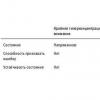Fermentation types. Course of lectures on the subject of Microbiology - file n1.doc
n1.doc
Alcoholic fermentationIn 1836, the French scientist Canyard de la Tour established that alcoholic fermentation is associated with the growth and reproduction of yeast. The chemical equation for alcoholic fermentation: C 6 H 12 O 6 2C 2 H 5 OH + 2CO 2 was given by the French chemists A. Lavoisier (1789) and J. Gay-Lussac (1815). L. Pasteur came to the conclusion (1857) that alcoholic fermentation can only be caused by live yeast under anaerobic conditions (“fermentation is life without air”). In contrast to this, the German scientist J. Liebig stubbornly insisted that fermentation takes place outside the living cell. The possibility of acellular alcoholic fermentation was first pointed out (1871) by the Russian physician-biochemist M.M. Manasseina. The German chemist E. Buchner in 1897, squeezing yeast pounded with quartz sand under high pressure, obtained a cell-free juice that ferments sugar with the formation of alcohol and CO 2. When heated to 50 ° C and above, the juice lost its fermentation properties. All this indicated the enzymatic nature of the active principle contained in the yeast juice. The Russian chemist L.A. Ivanov discovered (1905) that phosphates added to yeast juice increase the rate of fermentation several times. Research by domestic biochemists A.I. Lebedev, S.P. This type of fermentation is of the greatest economic importance.
Conclusion and main differences

Examples of cellular respiration with a parent inorganic substrate include iron bacteria, which are capable of oxidizing iron oxide to iron oxide and receiving energy from this reaction. These two are also oxidative processes, but fermentation never uses oxygen, and in the most common type of respiration, aerobic molecular oxygen is required as the final electron acceptor in the oxidative process. The electronic transport chain also does not interfere with fermentation.
Alcoholic fermentation is the process of decomposition of sugar into alcohol and carbon dioxide. It proceeds under the influence of microorganisms in the form of the following reaction:
C 6 H 12 O 6 = 2C 2 H 5 OH + 2CO 2 + 27 kcal
Ethyl carbonate sugar
Alcohol gas
Except ethyl alcohol and carbon dioxide, in this case, by-products are also obtained: acetaldehyde, glycerin, fusel oils (butyl, isobutyl, amyl and isoamyl alcohols), acetic and succinic acids, etc.
This implies that aerobic respiration always needs oxygen in the environment surrounding the body, that is, it needs aerobic environmental conditions. However, there are many organisms that ferment under aerobic environmental conditions, such as many yeasts. That is, internally, fermentation is an anaerobic process, but it can take place in an aerobic environment.
Another type of respiration, anaerobic respiration, does not use oxygen, but the electronic transport chain continues to interfere and combustion is still complete, the difference with aerobic respiration is that there is a substance other than molecular oxygen at the end of the electron transport chain. Anaerobic respiration, like fermentation, can occur in an aerobic environment depending on the organism, although it is an internal anaerobic process.
Alcoholic fermentation of carbohydrates is caused by yeast, some representatives of mucor fungi and some bacteria. However, fungi and bacteria produce significantly less alcohol than yeast.
Alcoholic fermentation has been used by man since ancient times in the manufacture of wine, beer, mash, etc. conditions.
Many organisms can perform fermentation or respiration according to the conditions to which the cell is exposed. For example, in humans, aerobic respiration degrades glucose to pyruvate, and pyruvate passes into the mitochondria, where it is oxidized to carbon dioxide and water, but if the oxygen supply is insufficient, for example, in muscle cells before intense or sudden exercise, pyruvate can follow the milk fermentation pathway. ...

At the same time, it can be concluded that the essential difference between respiration and fermentation lies in the participation of the electronic transport chain and subsequent complete combustion, and not in the presence or absence of oxygen. A is a chemical process that takes place without the use of gaseous oxygen, that is, anaerobic.
Sugar fermentation is a complex biochemical process, therefore the above equation expresses it only in a general summary form.
Yeast, depending on the conditions of fermentation, form different amounts of fermentation products, among them either ethyl alcohol and carbon dioxide, or glycerin and acetic acid can prevail. Moreover, they ferment not all sugars, but only monosaccharides (for example, glucose) and disaccharides (for example, maltose). Yeast is not capable of fermenting polysaccharides (starch), since they do not have the enzyme (amylase) necessary for the breakdown of polysaccharides.
This takes place in the cytoplasm, with the help of enzymes that act as accelerators of the process. Fermentation, as such, extracts energy from and can be amino acids, sugars and fats. With glucose, a second process occurs, called glycolysis. In it, phosphates are incorporated into the glucose molecule, which leads to the destruction of two molecules of pyruvic acid. In the case of fermentation where there is no oxygen, pyruvate is converted to lactic acid or ethanol. This is because fermentation is of several types.
Let's take a look at some of them. How milk fermentation takes place and what it generates. This type of fermentation is produced by lactobacilli, which are present in milk. These are the ones that create lactic fermentation that results in lactic acid. This process occurs when the milk sugar, lactose, is broken down, which unfolds in enzymatic actions. This process takes place outside the bacterial cells, because the next moment the monosaccharides enter the cells, which leads to fermentation.
Fermentation depends not only on the conditions in which it takes place, but also on the type and race of yeast used. These conditions include the concentration of sugar, the acidity of the environment, temperature, and the amount of accumulated alcohol.
The most favorable concentration of sugar in the fermentable substrate for most yeast is about 15%; at higher concentrations, fermentation slows down and then stops altogether. However, some yeast can cause fermentation even when the sugar content in the medium exceeds 60%. When the sugar concentration in the substrate is less than 10%, fermentation is very sluggish.
Taking this process as an example of our Everyday life We can identify lactic acid in the smell and sour taste of milk during the process. How alcohol fermentation occurs and what it generates. This type of fermentation is known to be produced by yeast, a type of unicellular fungus. It is a fermentation used for a variety of purposes and products.
Thus, the glucose molecule undergoes several reactions to create two pyruvic acid molecules. Finally, each pyruvic acid molecule goes through what is called decarboxylation to become ethyl alcohol or ethanol.
An acidic medium with a pH of 4 or 4.5 is normal for alcoholic fermentation.
V alkaline environment fermentation proceeds with the formation of glycerin and acetic acid.
The best fermentation temperature is between 28-32 ° C. At higher temperatures, fermentation slows down, and at 50 ° C it stops. Lowering the temperature reduces the energy of fermentation, although it does not completely stop even at 0 ° C.
Various beverages and foods can be made from this fermentation. We use an alcoholic fermentation process carried out by yeast to alcoholic beverages such as beer, kacchas and wine. How fermentation takes place in the body and what it generates.
Curiosity about fermentation
In this type of fermentation, acetobacteria are the main ones, which make the vinegar fermentation. Acetic acid is formed from this process, and with this element, sour wine and fruit juices, destined for the production of vinegars, can be produced. We do not get intoxicated when we eat bread, as is the case with drinks, because during fermentation molecules of carbon dioxide and molecules of ethyl alcohol are formed, and alcohols evaporate when the oven heats up when the bread is fired. And the evaporation of carbon dioxide molecules is responsible for keeping the bread growing until it's toasted.
In practice, fermentation processes are carried out at a temperature in the range of 20-28 ° C for top fermentation and within 5-10 ° C for bottom fermentation.
Top fermentation proceeds very vigorously, with the formation of a large amount of foam on the surface of the substrate and with a violent release of carbon dioxide, the streams of which carry the yeast into the upper layers of the substrate. The yeast that causes this fermentation is called riding yeast. After the end of fermentation, they settle to the bottom of the fermentation vessels.
Fermentation processes are essential for the planet's environment because soil-dwelling fungi, which are anaerobic, help break down organic material, helping to recycle and balance. Other types of yeast-derived foods are alcohol, glycerin, and carbon dioxide.
They are responsible for foods such as lactic acid, acetone, monosodium glutamate, and acetic acid. It is also impossible to find "good" anaerobic bacteria. In humans, lactic fermentation can also be identified in relation to lactic acid, which in excess can lead to muscle disorders and uncomfortable pain. For this, the amount of oxygen in muscle cells is greater than aerobic respiration and can resist the release of energy required for intense action. Therefore, while the cells are breathing, they begin to ferment some of the glucose in an attempt to release more energy.
Bottom fermentation, caused by bottom yeast, is much quieter, with a small amount of foam. Carbon dioxide is released gradually and the yeast remains in the lower layer of the fermentation substrate.
Horse yeast is used for the production of alcohol and baker's yeast, grass-root yeast - for the production of wine and beer. Mounted yeast is sometimes used to make wine and beer.
This action causes pain, fatigue and cramps caused by the lactic acid accumulated in muscle fibers. Thus, we could see that fermentation is divided into several types and is important for various purposes, whether it is for the production of food, drinks and food in general, or for the health of the planet and people.
Fermentations are chemical transformations that some microbes undergo to certain organic materials, thanks to the action of the enzymes they are equipped with. To characterize fermentation, you need to answer the following questions. What substance is being converted? - In what? - Under the influence of what?
The alcohol formed during fermentation has a detrimental effect on the yeast. When alcohol accumulates in the substrate more than 16% by volume of the substrate itself, fermentation stops, and the depressing effect of the formed alcohol begins to manifest itself already at a concentration of 2-5%. Some races of specially trained yeast are able to withstand very high alcohol concentrations - up to 20-25%.
Germs or Microorganisms: Microscopic creatures. All microbes are non-pathogenic. Most of them are useful and are used, for example, in the development of many products: wine, beer, cheese, bread, etc. Bacteria: microscopic, unicellular living things; Bacteria can be divided into 4 categories.
Beneficial bacteria that are involved in the preparation of the foods mentioned above: - Common bacteria, harmless except when their number becomes too important - Food spoilage bacteria. - Pathogenic bacteria responsible for infectious diseases or toxic infections.
Alcoholic fermentation normally proceeds under anaerobic conditions created during the fermentation itself. But because yeast is a facultative anaerobic, it can decompose sugar under aerobic conditions to form carbon dioxide and water. It has been noticed that in conditions of good aeration, yeast multiplies vigorously. Therefore, in the production of baker's yeast, the fermenting substrate is blown with air.
Note: These are bacteria that are responsible for malolactic fermentation. Yeast: single-celled creatures ten times larger than bacteria. Enzymes or diastases: soluble organic substances produced in very small quantities by a living organism and which specifically promote a reaction. Enzymes are proteins that act as catalysts. Most enzymes are essential for the life of the cells that belong to them.
What is being transformed? An essential result of alcoholic fermentation of grape juice is the complete or partial conversion of sugars into ethyl alcohol, carbon dioxide and by-products. Phenomena observed during alcoholic fermentation. Bubble of liquid during fermentation. Sometimes we talk about "vigorous fermentation". Temperature rise It must be constantly monitored, as we will see later. Increased content alcohol in relation to reducing sugars. Color change, this remark is especially true for red and rosé wines.
For the industrial production of alcohol, starch-containing products are used as raw materials - potatoes, grain crops, as well as sugar production waste. Due to the fact that yeast is not able to ferment starch, it is preliminarily saccharified with malt containing the enzyme amylase. Malt is obtained from sprouted barley grains. Currently, mushroom malt (mushrooms of the genus Aspergillus) is also used for saccharification, which in many respects is more beneficial than barley malt. As a result of saccharification of starch, the disaccharide maltose is formed - malt sugar.
Remember that alcoholic fermentation is smart. - temperature - alcohol. Alcoholic fermentation has been observed and used for a long time. It was he who first demonstrated that fermentations were not caused by the action of air on sugar, but by the presence of microbes, especially yeast. Glucose and sugars in the same category are decomposed into ethyl alcohol and carbon dioxide by the enzymes of the yeast, and alcoholic fermentation gives the yeast the energy it needs to multiply: it "burns" the sugars.
Referring to alcoholic fermentation, he proclaimed the famous principle: "Nothing is lost, nothing is created, everything is transformed." A sugar molecule gives two molecules of ethyl alcohol and two molecules of carbon dioxide. But also in the preparation of bread and other leavened pasta.
Prepared for fermentation, a liquid, sugary substrate called mash is acidified, and then yeast is added to it. The maltase enzyme produced by the yeast converts malt sugar into a monosaccharide - glucose, and the latter, with the help of the zymase enzyme, also secreted by the yeast, is split into alcohol and carbon dioxide. Later, many researchers studied in detail the enzymatic nature and mechanism of alcoholic fermentation. The first reaction of glucose conversion during alcoholic fermentation is the addition of phosphoric acid residue from adenosine triphosphoric acid to glucose under the influence of the enzyme glucokinase. This produces adenosine diphosphoric acid (ADP) and glucose-6-phosphoric acid. The latter, under the action of the enzyme glucose phosphatizomerase, is converted into fructose-6-phosphoric acid, which, receiving another phosphoric acid residue from the new ATP molecule (with the participation of the enzyme phosphofructokinase), is converted into fructose-1,6-diphosphoric acid. Under the influence of the enzyme ketose-1-phosphataldolase, fructose-1,6-diphosphoric acid is split into glycerolaldehyde phosphoric and dioxyacetone phosphoric acids, which can be converted into each other under the action of the enzyme triose phosphate isomerase. Glycerolaldehyde phosphoric acid, attaching a molecule of inorganic phosphoric acid and being oxidized by the enzyme dehydrogenase phosphoglycerolaldehyde, the active group of which in yeast is nicotinamide adenine dinucleotide (NAD), is converted into 1,3-diphosphoglyceric acid. The molecule of dioxyacetone phosphoric acid under the action of triose phosphate isomerase gives a second molecule of glycerolaldehyde phosphoric acid, which also undergoes oxidation to 1,3-diphosphoglyceric acid; the latter, giving ADP (under the action of the phosphoglycerate kinase enzyme) one phosphoric acid residue, is converted into 3-phosphoglyceric acid, which, under the action of the phosphoglycerol mutase enzyme, turns into 2-phosphoglyceric acid, and it, under the influence of the phosphoglycerate hydratase enzyme, into phosphogenol-pyruvic acid ... The latter, with the participation of the enzyme pyruvate kinase, transfers the phosphoric acid residue to the ADP molecule, as a result of which an ATP molecule and a phenolpyruvic acid molecule are formed, which is very unstable and passes into pyruvic acid. This acid, with the participation of the enzyme pyruvate decarboxylase present in yeast, is split into acetaldehyde and carbon dioxide. Acetic aldehyde, reacting with the reduced form of icotinamide adenine dinucleotide (NAD-H) formed during the oxidation of glycerolaldehyde phosphoric acid, with the participation of the enzyme alcohol dehydrogenase is converted into ethyl alcohol. In summary, the equation of alcoholic fermentation can be represented as follows:
It is often difficult to remember which acids are already in the wort and which are the result of alcoholic fermentation. The first letter of each word is the first letter of the acid. Pasteur, one of the greatest scientists of his time, not only invented the anti-rabid vaccine, but we owe him a wonderful work in the study of fermentation. He was the first to demonstrate that this was due to the action of microorganisms and that there was no "spontaneous generation" of living things. After graduating from the Graduate School of Normal Life, he completed his Ph.D. in physics and chemistry.
C 6 H 12 O 6 + 2H 3 PO 4 + 2ADP 2CH 3 CH 2 OH + 2CO 2 + 2ATP
Thus, during the fermentation of 1 mole of glucose, 2 moles of ethyl alcohol, 2 moles of CO 2 are formed, and as a result of phosphorylation of 2 moles of ADP, 2 moles of ATP are formed. Thermodynamic calculations show that during alcoholic fermentation, the conversion of 1 mole of glucose can be accompanied by a decrease in free energy by about 210 kJ (50,000 cal), i.e., the energy accumulated in 1 mole of ethyl alcohol is 210 kJ (50,000 cal) less energy 1 mole of glucose. The formation of 1 mole of ATP (high-energy - energy-rich phosphate compounds) uses 42 kJ (10,000 calories). Consequently, a significant part of the energy released during alcoholic fermentation is stored in the form of ATP, which provides a variety of energy needs of yeast cells. The same biological significance has a fermentation process in other microorganisms. With the complete combustion of 1 mole of glucose (with the formation of CO 2 and H 2 O), the change in free energy reaches 2.87 MJ (686,000 cal). In other words, the yeast cell uses only 7% of the glucose energy. This shows the low efficiency of anaerobic processes in comparison with processes in the presence of oxygen. In the presence of oxygen, alcoholic fermentation is inhibited or stopped, and the yeast receives energy for life in the process of respiration. There is a close relationship between fermentation and respiration of microorganisms, plants and animals. The enzymes involved in alcoholic fermentation are also found in the tissues of animals and plants. In many cases, the first steps in the breakdown of sugars, up to the formation of pyruvic acid, are common for fermentation and respiration. The process of anaerobic breakdown of glucose is also of great importance during muscle contraction; the first stages of this process are also similar to the initial reactions of alcoholic fermentation. Fermentation of carbohydrates (glucose, enzymatic starch hydrolysates, acid wood hydrolysates) is used in many industries: to obtain ethyl alcohol, glycerin and other technical and food products. Alcoholic fermentation is the basis for dough preparation in the bakery industry, winemaking and brewing. In alcohol production, yeast races are used that are able to quickly and completely ferment sugar and are resistant to alcohol. For the production of beer, barley is most often used, from which malt is obtained, and a wort-sugary liquid is prepared from malt, which is subjected to fermentation.
He begins to study lactic fermentation and then alcoholic fermentation, confirming that all fermentations are due to living things and that each species causes a specific fermentation. Passionate in his medical research, Pasteur may not have conducted alcoholic fermentation experiments if Claude Bernard's posthumous article had challenged his theory of alcoholic fermentation. In response to this publication, Pasteur wrote: "The last twenty lines of Claude Bernard's article are an absolute condemnation of my views on fermentation, but Herr Bernard was wrong."
Taste features of beer depend on the quality of raw materials, technology and yeast used. Bottom yeast used in brewing is slow fermentation, does not cause significant clouding of the wort, and upon completion of fermentation it forms a dense sediment at the bottom. Among the grass-roots yeast, there are highly fermenting and low-fermenting yeasts.
In winemaking, until recently, yeast did not play the predominant role that falls on their share in the production of beer. The bulk of the wine was obtained by self-fermenting the must with the help of random yeast found on grapes. The use of pure cultures in winemaking makes it possible to ferment the grape must faster and more fully and get a wine with a good bouquet. Certain races of wine yeast during the fermentation of grape must are capable of accumulating up to 10-14% alcohol. Each wine region has yeast races specific to the area, so the variety of the resulting wine is determined not only by the grape variety and technology, but also by the biological characteristics of the yeast used.
Pure yeast cultures are necessarily used in the production of sparkling wines.
In the production of fruit and berry wines, the appropriate races of wine yeast are selected for each type of fruit or berry, which makes it possible to obtain high quality wines.
To obtain bread dough, baker's yeast is used, which has good lifting power and the ability to multiply quickly. Alcohol and carbon dioxide formed during fermentation loosen and raise the dough, and fermentation by-products give the bread a special taste and aroma.
In the production of bread, pressed and liquid yeast, as well as sourdoughs are used. Compressed yeast is perishable and must therefore be stored at low temperatures. The admixture of wild yeast and bacteria in the pressed yeast indicates their low quality.
Liquid yeast is made directly in bakeries. Unlike compressed yeast, it also contains lactic acid bacteria. By producing lactic acid, lactic acid bacteria prevent the development of potato sticks in the dough, which causes sticky bread disease.
Starter cultures are dough left over from previous baked goods. They are used to loosen rye dough. Starter cultures contain yeast and lactic acid bacteria.
Foreign microorganisms can enter the environment of cultivated yeast, which is used in production, causing spoilage of products. Thus, wild yeast is often a pest in the production of wine and beer. They alter the taste and smell of these products and cause them to become cloudy. Filmy yeast mycoderm is especially dangerous. Developing in wine and beer, they oxidize alcohol to carbon dioxide and water and give the drinks an unpleasant taste.
Micoderma is also harmful in the production of baker's yeast. The process of obtaining baker's yeast is carried out by blowing the substrate with air, as this contributes to their rapid multiplication. Mycoderm develops faster under these conditions than real yeast. Since mycoderma does not have the ability to raise the dough, its presence in cultured yeast dramatically reduces its baking properties.
Certain types of lactic acid bacteria, which cause turbidity in wine and beer, are also pests of fermentation plants. Certain representatives of spherical bacteria (pediococci) can give beer a special flavor and turbidity, and sometimes lick it. Acetic acid bacteria can spoil wine by oxidizing alcohol to acetic acid.
Lactic acid bacteria are divided into 2 groups - homofermentative and heterofermentative. Homofermentative bacteria (for example, Lactobacillus delbrückii) break down monosaccharides to form two lactic acid molecules according to the general equation:
C 6 H 12 O 6 = 2CH 3 CHOH-COOH
Heterofermentative bacteria (for example, Bacterium lactis aerogenes) ferment with the formation of lactic acid, acetic acid, ethyl alcohol and CO 2, and also form a small amount of aromatic substances - diacetyl, esters, etc.
During lactic acid fermentation, the conversion of carbohydrates, especially at the first stages, is close to alcoholic fermentation reactions, with the exception of decarboxylation of pyruvic acid, which is reduced to lactic acid due to hydrogen obtained from NAD-H. Homofermentative lactic acid fermentation is used to obtain lactic acid, in the manufacture of various sour dairy products, bread and in the silage of feed in agriculture... Heteroenzymatic lactic acid fermentation occurs when preserving various fruits and vegetables by fermentation.
Lactic acid fermentation is the decomposition of sugar by the action of lactic acid bacteria to form lactic acid. In its general summary form, it can be represented by the following equation:
C 6 H 12 O 6 = 2C 3 H 6 O 3 + 18 kcal.
This fermentation is often observed in milk and causes it to sour. Hence the name of the type of fermentation, the bacteria that cause it, as well as the main fermentation product - acid. Lactic acid bacteria are spherical and rod-shaped. They are immobile, do not form spores, and are facultative anaerobes.
Different types of lactic acid bacteria produce different amounts of acid under equal conditions, which is explained by their unequal acid resistance. Rod-shaped bacteria produce more acid than globular bacteria (cocci).
Lactic acid bacteria are able to ferment only mono- and disaccharides and do not ferment starch and other polysaccharides at all, since they do not secrete the corresponding enzymes.
Some of these bacteria produce antibiotic agents that work against intestinal pathogens.
Lactic acid bacteria are widespread in nature, they are constantly found in the soil, on various plants, on fruits and vegetables, in milk, etc.
The most important are the following lactic acid bacteria: lactic acid streptococcus, Bulgarian, acidophilus, cheese, Delbrück, cucumber, cabbage sticks, etc.
Lactic acid streptococcus - spherical bacteria connected in pairs or in short chains. They develop best at a temperature of 30-35 ° С, their temperature minimum is about 10 ° С. During fermentation, up to 1% acid is accumulated. They are widely used for the preparation of lactic acid products (yogurt, kefir, sour cream, cottage cheese, etc.).
The Bulgarian stick often forms long chains, isolated from the Bulgarian curdled milk. It is a motionless, indisputable stick. The best temperature for its development is 40-45 ° С, the temperature minimum is 20 ° С. In milk it forms up to 3.5% of lactic acid.
Acidophilus bacillus obtained from intestinal secretions infant... It has a temperature optimum of about 40 ° C, a minimum development temperature of 20 ° C. In milk it accumulates up to 2.2% of lactic acid. It is used for the preparation of lactic acid products - acidophilus and acidophilus milk.
The cheese stick has a temperature optimum of about 40 ° C and is used in cheese making.
Delbrück's bacillus is a single cell or cells collected in short chains that do not form spores. Temperature optimum 45 ° C. Forms up to 2.5% acid in the medium. It is used for the industrial production of lactic acid, as well as in the production of bread starter cultures.
Cucumber and cabbage sticks develop when pickling vegetables. Lactic acid fermentation is of great industrial importance. It is used in the production of lactic acid products, in bakery, in the processes of pickling vegetables and ensiling feed, in the manufacture of kvass, in the production of lactic acid, etc.
Lactic acid bacteria are among the permanent inhabitants of milk and cause a number of biochemical processes in it. In addition to these bacteria, various putrefactive bacteria can be found in milk. The number of microorganisms and their composition in milk can vary considerably. Freshly milked milk contains microorganisms that enter it from the ducts of the mammary glands of the udder, in which they live constantly.
Often there are several times more putrefactive bacteria in freshly milked milk than lactic acid bacteria. However, the developing lactic acid bacteria form lactic acid, which suppresses the vital activity of putrefactive bacteria.
After some time, mainly lactic acid bacteria remain in the milk, which continue to multiply and accumulate lactic acid, under the influence of which the milk soon coagulates. The yogurt obtained in this way (samokvass) usually has an unpleasant taste and smell, since it contains the waste products of other microorganisms. Eating self-brew milk is dangerous to health, as it may contain pathogenic microorganisms that have retained their viability, despite the formation of lactic acid.
When obtaining lactic acid products (yogurt, kefir, acidophilus, etc.) in production conditions, milk is preliminarily subjected to pasteurization, and then fermented with special ferments containing cultures of lactic acid bacteria. This makes it possible to obtain lactic acid products of a certain and high quality.
Lactic acid fermentation in bakery prevents the development of harmful bacteria in the dough that cause potato disease (stringiness) of the bread, and also helps to improve the taste of bread.
The lactic acid resulting from this fermentation gives a special taste to pickled vegetables and prevents the growth of putrefactive bacteria.
In the industrial production of lactic acid, starch, molasses and other sugary materials are used as raw materials. Lactic acid is used in the confectionery industry and in the production of soft drinks.
Propionic acid fermentation
Propionic acid fermentation is the process of converting sugar or lactic acid into propionic and acetic acids with the formation of carbon dioxide and water:
3C 6 H 12 O 6 = 4C 2 H 5 COOH + 2CH 3 COOH + 2CO 2 + 2H 2 O
3C 3 H 6 O 3 = 2C 2 H 5 COOH + CH 3 COOH + CO 2 + H 2 O
Fermentation is caused by propionic acid bacteria. These are short, motionless, unsporeable anaerobic rods, the optimum temperature for development of which is about 30 ° C. Propionic acid bacteria are close to lactic acid bacteria and often develop together with them.
It should be noted that not only lactic acid, but also its salts can undergo propionic acid fermentation. This fermentation is essential in the maturation of the cheeses. Lactic acid (or rather, its calcium salt), formed as a result of the vital activity of lactic acid bacteria, under the influence of propionic acid bacteria turns into propionic acid, acetic acid and carbon dioxide. The release of carbon dioxide leads to the formation of eyes in the cheese, giving it a characteristic spongy pattern. Propionic and acetic acids contribute to the formation of a specific cheese flavor and aroma.
Propionic acid bacteria are also used to obtain vitamin B 12.
Butyric acid fermentation
During butyric fermentation, the process of decomposition of sugar under the action of bacteria under anaerobic conditions occurs with the formation of butyric acid, carbon dioxide and hydrogen. It flows according to the equation:
C 6 H 12 O 6 = C 3 H 7 COOH + 2CO 2 + 2H 2 + 20 kcal
In this case, ethyl and butyl alcohols, acetic acid, etc. are obtained as by-products. Such fermentation can take place in milk and dairy products, giving them an unpleasant taste and smell characteristic of butyric acid. Butyric acid bacteria, causing this fermentation, are peritrichially bundled, mobile, spore-forming rods, the temperature optimum of their development is in the range of 30-40 ° C. They are strict anaerobes and can reproduce only in the complete absence of oxygen in the air or with very little oxygen content. Spores formed by butyric acid bacteria are very resistant to adverse effects, withstand boiling for several minutes and die only with prolonged sterilization. They are located either in the middle or closer to one of the ends of the cage, giving it the shape of a spindle or tennis racket.
Butyric acid bacteria are able to ferment both simple sugars and more complex carbohydrates - starch, pectin and others, as well as glycerin. These bacteria are widespread in nature, being in the soil, in the silt of lakes, ponds and marshes, in accumulations of various residues and waste, manure, polluted water, milk, cheese, etc. The fermentation caused by these bacteria is important in the transformation of substances into nature.
In the national economy, butyric acid fermentation can do great harm, since butyric acid bacteria can cause massive death of potatoes and vegetables, rancid milk and swelling of cheeses, spoilage of canned food, etc.
Butyric acid bacteria are overwhelmingly affected by the acidic reaction of the environment, therefore, where lactic acid bacteria develop, secreting lactic acid, the vital activity of butyric acid bacteria is suspended. If, however, fermented vegetables slowly accumulate lactic acid, then they can be spoiled as a result of the multiplication of butyric acid bacteria in them. These bacteria cause spoilage of pasteurized milk, in which lactic acid fermentation is excluded, as well as raw milk during long-term storage in the cold, when the activity of lactic acid bacteria is weakened.
Developing in wet flour, butyric acid bacteria give it a rancid taste. Butyric acid fermentation finds practical application in the production of butyric acid, which is widely used in technology.
Fermentation of pectin substances
Pectin substances are found in plants and play an important role in the structure of plant tissues. These substances form intercellular plates and glue plant cells together, uniting them into a single whole into tissue. The pulp of fruits, berries, roots, leaves of plants, etc. are rich in pectin substances. There are especially many of them in apples and other fruits, which are used to obtain a jelly-like mass, widely used in confectionery production (in the manufacture of marmalade, pastille, etc.). These substances are composed of pectin acids and carbohydrates. They do not dissolve in water. However, during boiling, pectin substances change from an insoluble form (protopectin) into a soluble form (pectin), as a result of which the bond between cells is weakened or completely destroyed. This explains the softening of vegetable products after prolonged boiling.
Under the action of bacteria, pectin substances undergo fermentation close to butyric acid, as a result of which they decompose into simpler substances with the formation of butyric and acetic acids, ethyl alcohol, carbon dioxide, hydrogen, etc.
Fermentation leads to the destruction of the connection between cells and the decay of plant tissues. The causative agents of fermentation are mobile, spore-forming bacteria related to facultative anaerobes.
Fermentation of pectin substances has great importance in nature, as it leads to the destruction of various plant materials. It constantly flows in soil and water containing plant residues.
Pectin fermentation is used for water lobes of flax and other fibrous plants.
Decomposition of fiber
Fiber (cellulose) is the main constituent of plant tissues. It is a complex polysaccharide with great chemical resistance. However, some bacteria and fungi release enzymes that break down fiber. Decomposition of cellulose occurs constantly in nature and can take place under both anaerobic and aerobic conditions. Fermentation of cellulose consists in the destruction of cellulose under anaerobic conditions with the formation of butyric and acetic acids, carbon dioxide, hydrogen or methane. The essence of cellulose fermentation was discovered in 1902 by Omelyansky, who identified two types of bacteria that destroy cellulose: one of them ferments cellulose with the formation of predominantly hydrogen (hydrogen fermentation), and the other - methane (methane fermentation).
Omelyansky's bacteria are spore-forming anaerobic rods, which have an optimal temperature for development of about 30 ° C; they are widespread in nature.
Certain thermophilic bacteria also cause fiber fermentation. They form spores and are facultative anaerobes that develop well at temperatures of 60-65 ° C.
Fermentation of cellulose is used in technology to obtain flammable gases, as well as acetic and formic acids from sawdust, straw and other plant materials rich in cellulose.
Aerobic fiber breakdown occurs under the influence of various microorganisms - fungi and aerobic bacteria. These include many fungi from the genera Penicillium, Aspergillus, Botrytis, Cladosporium and others, as well as actinomycetes and myxobacteria. Aerobic breakdown of cellulose is of great importance in the processes of decomposition of various plant residues and their mineralization in nature. As a result of the decomposition of cellulose, as well as other organic compounds, humus is formed in the soil under the influence of fungi and bacteria - a dark-colored substance that characterizes chernozem soil.
Oxidation processes
Among oxidative processes, acetic acid and citric acid fermentation are of the greatest practical importance.
Both of these fermentation are among the oxidative processes associated with the vital activity of microorganisms under aerobic conditions using atmospheric oxygen and are called fermentation only conditionally.
Acetic acidfermentation
Acetic acid fermentation is the oxidation of ethyl alcohol to acetic acid under the influence of acetic acid bacteria.
It can be expressed by the following summary equation:
C 2 H 5 OH + O 2 = CH 3 COOH + H 2 O
This fermentation, like alcoholic fermentation, has been known for a long time. For a long time, people have observed that a grayish film forms on the surface of wine or beer left in an open vessel, and the contents turn into vinegar. The microbiological nature of this process was first established in 1862 by Pasteur.
The causative agents of acetic acid fermentation are acetic acid bacteria, which make up a large group of rod-shaped, non-spore, aerobic bacteria. Among them there are mobile and stationary forms. They also differ in cell size, different resistance to alcohol and the ability to accumulate more or less acetic acid.
Acetic acid bacteria withstand an alcohol concentration of 10-12% and form in the medium from 6 to 11.5% vinegar.
The optimum temperature for their development ranges from 20-35 ° C. Acetic acid bacteria can join in long strands or form films on the surface of the substrate. They are widespread in nature and are found on ripe berries, fruits, wine, beer, kvass, pickled vegetables, etc.
In practice, acetic fermentation is used to make vinegar.
The initial substrate for the production of vinegar is grape or fruit wine, and most often - a solution containing alcohol and acidified with vinegar in order to create favorable conditions for acetic acid bacteria. Mineral salts and other nutrients necessary for bacteria are also added to such a solution.
After fermentation, the content of acetic acid in the substrate can reach up to 9%. This vinegar is diluted to a content of 4.5-6% acetic acid, and then sent to the market.
Citric acid fermentation
During citric acid fermentation, sugar under the influence of fungi is oxidized into citric acid. This acid was previously obtained from citrus juice - lemons and oranges. Currently, it is produced mainly by fermentation. Aspergillus niger mushroom is used as a causative agent of citric acid fermentation.
The raw material for the production of citric acid is a sugar-containing product - molasses. The molasses solution, containing about 15% sugar and the nutrients necessary for the fungus, is poured into flat open vessels and inoculated with the spores of the fungus. The vessels are placed in fermentation chambers, which are well ventilated. The fermentation process continues for 6-8 days at a temperature of about 30 ° C.
At the end of fermentation, the molasses solution is drained from under the fungus film, then citric acid is isolated from it, which is subjected to subsequent purification and crystallization. The citric acid yield is 50-60% of the amount of consumed sugar.
Recently, a new method of obtaining citric acid is being used. In this case, the fungus is not located on the surface of the fermentable substrate, but is introduced by its mycelium into the thickness of the substrate, which is energetically saturated with air. This method accelerates the accumulation of citric acid in the fermentable substrate.
Citric acid finds wide practical application, it is used, for example, in the manufacture of confectionery and culinary products, soft drinks, etc.
Fermentation of proteins
Some bacteria from the genus Clostridium - putrefactive anaerobes - are able to ferment not only carbohydrates, but also amino acids. These bacteria are more adapted to the use of proteins, which they break down with the help of proteolytic enzymes to amino acids, which are then fermented. The process of fermenting proteins is important in the cycle of substances in nature.
Breakdown of fats
Various physical and chemical factors, as well as microorganisms, can cause decomposition and spoilage of fats.
The initial stage in the breakdown of fats is their hydrolysis (saponification) into glycerol and fatty acids. This process easily occurs at high temperatures under the action of alkalis or acids. Under the influence of enzymes (lipases), girdolysis proceeds at ordinary temperatures. Saponification of fats by enzymes occurs, for example, during the digestion of fats in the digestive tract of animals. Fat-breaking enzymes are produced by many microorganisms.
The glycerol and fatty acids formed as a result of hydrolytic cleavage are then further degraded. The most easily destroyed is glycerin, which serves as a carbon source for many microorganisms. The breakdown of glycerol can occur under aerobic and anaerobic conditions.
Fatty acids are less susceptible to destruction, however, they are gradually oxidized, mainly under aerobic conditions. The final stage of the destruction of glycerin and fatty acids is their mineralization, accompanied by the formation of carbon dioxide and water.
The most actively decompose fats are some pigment and fluorescent bacteria, micrococci and actinomycetes, as well as mold fungi, especially oidium lactis and many species of the genera Aspergillus and Penicillium.
The decomposition of fats by microorganisms in soil and water occurs constantly, it is an integral part of the general circulation of substances in nature.
Microbial spoilage of dietary fats is often highly damaging. The development of microorganisms in fats is facilitated by the presence of water and organic impurities in them. Therefore, the less moisture the fat contains and the more completely it is cleaned of impurities, the better it is preserved.
Putrefactive processes
Decay is the decomposition of protein substances by microorganisms. Proteins are the most important component of the living and dead organic world and are found in many foods. Proteins are characterized by a great variety and complexity of the structure.
The ability to destroy protein substances is inherent in many microorganisms. Some microorganisms cause a shallow breakdown of protein, others can break it down more deeply. Putrefactive processes constantly occur in natural conditions and often occur in products and articles containing protein substances. Protein degradation begins with its hydrolysis under the influence of proteolytic enzymes released by microbes into the environment. Protein hydrolysis proceeds in several stages. The primary products of hydrolysis are peptones and polypeptides that differ little from the initial protein, but have a lower molecular weight. Peptones and polypeptides are then cleaved more deeply to form amino acids, which are the end products of hydrolysis.
The process of protein hydrolysis can be represented as the following scheme: protein peptones polypeptides amino acids.
Amino acids undergo further decomposition, resulting in the formation of various decay products, many of which are characterized by an unpleasant odor (ammonia, hydrogen sulfide, indole, skatole, mercaptans, etc.).
Organic compounds resulting from the breakdown of amino acids under aerobic conditions undergo subsequent oxidation up to complete mineralization. As the end products of putrefaction, ammonia, carbon dioxide, water, hydrogen sulfide and phosphoric acid salts, that is, minerals, are formed.
Under anaerobic conditions, there is no complete oxidation of organic compounds, which are the decomposition products of amino acids.
Therefore, in addition to ammonia and carbon dioxide, various organic acids, alcohols, amines and other organic compounds accumulate among the final substances of putrefaction, imparting a disgusting sickening smell to the putrefactive material. Putrefactive microorganisms are widespread in nature.
Among the putrefactive microorganisms, bacteria are of the greatest importance. Putrefactive bacteria are spore-forming and non-spore-forming, aerobic and anaerobic.
More often than others, the following aerobic bacteria cause rotting: bacillus subtilis (hay bacillus) and bacillus mesentericus (potato stick). Both of these bacteria are mobile and form spores that are resistant to high temperatures.
The hay stick constantly lives in the hay, which is why it got its name. Develops on hay infusion in the form of a film. Hay bacillus is capable of producing antibiotic substances that suppress the vital activity of many pathogenic and non-pathogenic bacteria. The optimum temperature for its development is 37-50 ° C. When it breaks down proteins, a lot of ammonia is released.
Potato sticks are more active in breaking down proteins than hay. The optimum temperature for its growth is 36-45 ° С.
The potato stick (hay stick to a lesser extent) can cause the previously mentioned potato disease in baked bread, as a result of which it becomes stringy and sticky. Such bread is unsuitable for food. Both bacteria can cause spoilage of many other products - dairy and confectionery products, potatoes, fruits, etc.
The bacillus is also among the putrefactive bacteria that destroy protein substances under aerobic conditions. mycoides. This bacterium is widespread in the soil. It is a mobile spore-forming stick.
The most common and active causative agents of putrefaction under anaerobic conditions are bacillus putrificus and bacillus sporogenes.
Putrificus is a mobile, spore-forming rod, vigorously decomposes proteins with the release of a large amount of gas.
Sporogenes is a mobile, spore-forming bacillus that produces a lot of hydrogen sulfide during the decomposition of proteins. Its spores are thermally stable. The optimum temperature for development is 37 ° C.
Among the facultative anaerobes, protein breakdown causes proteus vulgaris (proteus). Bacteria are small, indisputable, highly mobile rods. This bacterium has the ability to change shape and size on different nutrient substrates, as a result of which it received the name of the mythical god Proteus, whose extraordinary transformations are described in the famous "Odyssey" by Homer. During the decomposition of protein, Proteus forms hydrogen sulfide and indole, and on media rich in carbohydrates, it releases large amounts of carbon dioxide and hydrogen. It develops well at temperatures ranging from 25-37 ° C.
Coli bacterium (Escherichia coli) is often involved in putrefactive processes. This bacterium is a short, mobile, indisputable bacillus related to facultative anaerobes. It constantly lives in the intestines of humans and animals and enters the soil along with manure. Proteus and Escherichia coli, once on food, are capable, under certain conditions, to accumulate toxic substances causing poisoning when using these products.
Putrefactive microorganisms include many non-spore pigment bacteria, fluorescent bacteria, actinomycetes, and various molds.
Thus, putrefactive processes are caused by a variety of microorganisms, the composition of which depends on the nature of the decomposed protein substance and the surrounding conditions.
The optimum temperature for development for most of the putrefactive microorganisms is in the range of 25-35 ° C. Low temperatures do not cause their death, but only stop their development. At a temperature of 4-6 ° C, the vital activity of putrefactive microorganisms is suppressed. Non-spore putrefactive bacteria die at temperatures above 60 ° C, and spore-forming bacteria can withstand heating up to 100 ° C.
In nature, decay plays a large positive role. It is an integral part of the cycle of substances. Putrefactive processes ensure the enrichment of the soil with the forms of nitrogen that plants need.
However, putrefactive microorganisms can spoil many foods and materials containing protein. To prevent spoilage of products by putrefactive microorganisms, a storage regime should be provided that would exclude the development of these microorganisms.
LECTURE number 8
Microbiological control
quality of goods
Pathogenic microorganisms
and foodborne diseases caused by them
Among the many microorganisms, there are those that cause diseases in humans, animals and plants. They are called pathogens, or pathogens.
The most important feature of pathogenic microbes is their ability to produce poisonous substances called toxins in the affected organism. Many toxins are extremely toxic, far superior to inorganic poisons. It is toxins that are usually the cause of the disease state of the infected organism.
The toxins produced by pathogenic microbes are divided into two types: exotoxins and endotoxins.
Exotoxins are released by the microbial cell into the environment. They are protein substances and are destroyed when heated above 70 ° C.
Endotoxins are not excreted by microorganisms. During the life of a microbial cell, they remain inside the cell and are released only after its death and destruction of the cell membrane.
Endotoxins include complex protein compounds and polysaccharides. They are more resistant to high temperatures than exotoxins and can withstand heating up to 80-100 ° C.
Rickettsiae are found in the form of coccoid, rod-shaped, bacillary and filamentous forms.
Pathogenic bacteria are caused, for example, by diseases such as tuberculosis, syphilis, relapsing fever, tetanus, gangrene, anthrax, brucellosis, typhoid fever, dysentery, paratyphoid fever, botulism, etc.
Influenza, rabies, measles, smallpox, rinderpest, foot and mouth disease and other diseases are caused by viruses. Some fungi are the cause of ergotism, septic sore throat, etc.
Rickettsiae causes typhus fever, Rocky Mountain spotted fever, Q fever, tsutsugamushi fever, and other diseases in humans. Of these, the most malignant are Rocky Mountain spotted fever (America) and tsutsugamushi fever (Japan). Treatment of diseases caused by rickettsia, like many other diseases, is successfully carried out with antibiotics (synthomycin, biomycin, chloromycetin, etc.).
Most of these diseases are associated with the penetration of their pathogens - living pathogenic microbes - into the human or animal organism. Some of these diseases (for example, botulism, ergotism, etc.) can occur when only microbial toxins enter the body in the absence of living toxin-forming microbes.
The penetration of pathogens into the human or animal body is called an infection. This term also usually denotes infectious diseases, that is, diseases that are contagious.
Sources of infection are primarily sick people and animals that release disease-causing microbes into the environment. People and animals who have been ill can also spread infections, in whose body pathogenic microbes continue to remain for some time (sometimes many months) after recovery. People and animals that release pathogenic microbes after suffering a disease are called bacteria carriers. Sometimes the bacteria carriers are also healthy people who did not suffer from this disease.
The pathogenic microbes isolated by the sick organism enter the air, water, soil, surrounding objects and food, where they can remain viable for some time.
Into the body healthy people pathogenic microorganisms can penetrate as a result of direct contact with a sick person or indirectly: through air, water, soil, food, household items that the patient used, etc.
Through the air, infectious agents spread along with the smallest droplets of saliva released into the air by the patient during a conversation, coughing and sneezing (droplet infection), or with dust (dust infection). Germs that cause some diseases are excreted by patients with feces and urine (intestinal infections). Such microbes can enter the body of a healthy person through dirty hands that have not been washed after using the toilet. Contaminated hands also spread pathogens to food, which can then become transmitters of infection. Causative agents intestinal infections penetrate into a healthy body also when drinking contaminated water, in which some microbes can not only persist, but also multiply.
Infectious diseases are often carried by some insects and rodents. Flies can carry the causative agents of typhoid and dysentery, lice - typhus, some types of mosquitoes - malaria, fleas - bubonic plague. Mice and rats spread the causative agents of plague, tularemia, anthrax, and food poisoning.
The rabies virus is transmitted by sick animals, most often dogs, through bites.
Pathogens of gas gangrene, tetanus, etc. can be transmitted through the soil.
However, the penetration of pathogenic microbes into the human body does not always lead to its disease. Consequently, for the emergence and development of an infectious disease, it is not enough just for the pathogen to enter a healthy body. In the onset and course of the disease, the properties of pathogenic microbes that have entered the body, their number and activity, as well as the place of entry into the body, play an important role. The causative agent of dysentery, for example, can cause disease only if it enters the body through the mouth, and its penetration through the skin does not lead to disease; tetanus bacillus causes disease in the body if it enters it through a wound in the skin, but cannot cause disease if it enters the body through the mouth.
Favorable conditions are needed for the reproduction of pathogenic microbes, and they appear when the human body is weakened and its protective ability is reduced (for example, during fasting, during hypothermia, after suffering another disease, etc.). The severity of the disease also depends on the state of the human body. Often, the same disease in different people is not the same for some - sharply expressed, with all characteristic symptoms, in others it is less pronounced, and in others it is so imperceptible that they do not feel unhealthy, and the disease is established only on the basis of laboratory studies.
Susceptibility to infection also depends on age; it is higher in children than in adults.
From the moment pathogenic microbes enter the human body until signs of the disease appear, a certain period of time usually passes. This period is called the latent period of the disease, or the incubation period. During this time, there is a multiplication of pathogenic microorganisms and the accumulation of harmful products of their vital activity. Duration incubation period different diseases are not the same. It ranges from several days (anthrax, tetanus) to several weeks (typhus, typhoid fever). Some diseases have an incubation period of months (rabies) and even years (leprosy). After the incubation period, painful symptoms characteristic of each infectious disease begin to appear.
Immunity and prevention of infectious diseases
The human body has certain protective properties and resists the infection that has entered it.
It has been noticed that in different people this resistance is manifested to a different extent, and persons who have undergone some diseases (smallpox, cholera, etc.) a second time with these diseases, as a rule, do not fall ill. The body's immunity to the harmful effects of pathogenic microbes is called immunity.
Resistance and immunity of the body to infectious diseases are associated with the protective activity of certain tissues, cells and body fluids. The protective function is performed by the skin and mucous membranes of the mouth, nose, respiratory tract, intestines and other organs, which not only prevent the penetration of microbes into tissues and organs, but also release bactericidal substances that have a detrimental effect on microorganisms.
Tears, saliva, blood serum, gastric and intestinal juices also have bactericidal properties.
When these natural protective agents are not enough, the body attracts special, more effective forces to fight the pathogenic microbes that have penetrated into it, which include white blood cells - leukocytes. The founder of the doctrine of the role of these bodies or cells in the fight against infection is II Mechnikov. In his remarkable works, he showed that these cells are capable of capturing microbes and digesting them. He called such cells phagocytes, that is, eaters, and the very phenomenon of the destruction of microbes by these cells was phagocytosis.
Subsequently, studies by other scientists have established that many other cells of the body also have phagocytic ability, for example, cells connective tissue, spleen, bone marrow, cells lining blood and lymph vessels from the inside, etc.
Blood plasma also plays an important role in protecting the body from pathogenic microbes. When pathogenic microbes or toxins enter the body, special protein substances appear in it, suppressing the activity of microbes and neutralizing their toxins. These substances are called antibodies, they are produced by the spleen, bone marrow, lymph glands, etc.
The effect of antibodies on microbial cells is manifested in different ways. Some antibodies cause dissolution (lysis) of microorganisms, others glue microbial cells together, the property of third antibodies is to neutralize toxins.
The formation of antibodies and their accumulation in the blood plasma also occurs when any foreign protein or enzyme enters the body.
All substances that cause the formation of antibodies are called antigens. The interaction between antibody and antigen is highly sensitive and selective. If, for example, a culture of Vibrio cholerae is introduced to a rabbit, then antibodies will appear in its blood plasma, paralyzing the activity of only the cholera pathogen.
The activity of the central nervous system plays an exceptional role in the body's ability to resist infection.
In accordance with the teachings of Academician I.P. Pavlov, it is a regulator physiological functions organism, which include the formation of phagocytes and antibodies.
The totality of all the protective properties of the body, mobilized by it when pathogenic microbes enter the body, underlies its immunity.
Immunity can be natural or artificial.
Natural immunity occurs naturally in the body. If the body has natural immunity against a particular disease from birth, such immunity is called innate. Immunity can also arise as a result of the transfer of an infectious disease by the body; in this case, natural immunity is called acquired. For example, smallpox, measles, whooping cough and other diseases leave behind a stable immunity, and flu, pneumonia, diphtheria do not create immunity in people who have had them and can be repeated several times.
Artificial immunity is created in the body as a result of the introduction into it special drugs- vaccines and serums.
Artificially, doctors tried to create immunity to infectious diseases in the past centuries. Among many diseases, a particular danger was up until the middle of the 19th century. represented smallpox, the diseases of which were often epidemic.
As a result of observations of patients with smallpox, it turned out that people who had been ill with smallpox in a mild form became immune to this disease. In a number of countries, rubbing of smallpox crusts taken from sick people into the skin of healthy people began to be used, although at that time no one, of course, knew the reasons for the appearance of infectious diseases. However, after such vaccinations, the disease often proceeded not in a mild, but in a very severe form and was fatal.
Later, at the very end of the 18th century, when the microbial origin of smallpox was still not known, the English physician Jenner successfully used the vaccination of vaccinia in humans to combat this disease, based on the fact that people who have had vaccinia do not get sick with human smallpox.
The development of a method for protecting a person from infectious diseases and its widespread use began in the second half of the 19th century. Louis Pasteur. He established the possibility of weakening artificially pathogenic properties of pathogenic microbes and showed that the introduction of weakened microbes into a healthy body does not cause disease in a dangerous form and at the same time develops immunity to this disease in it.
The introduction of live weakened microbes into a healthy body for the purpose of immunization is called a preventive vaccination. Pasteur managed to get protective vaccinations against rabies, anthrax and some other diseases. Subsequently, Russian researchers L. S. Tsenkovsky, N. F. Gamaleya, Z. K. Zabolotny, and others made a great contribution to the development of the theory of artificial immunity. Preventive vaccinations became a powerful weapon of medicine in the fight against infectious diseases.
At first, live weakened microbes were used for protective vaccinations, but then it turned out that killed pathogenic microorganisms, as well as their neutralized toxins, can be used as vaccinations. All of these vaccines used to obtain artificial immunity are called vaccines.
On the basis of Michurin's doctrine of directed variability of organisms, very effective live vaccines have been created against many infectious diseases. These vaccines are obtained by cultivating various pathogenic microorganisms under certain conditions, as a result of which races are grown that have lost their disease-causing properties, but retain the ability to induce immunity. This is how live vaccines against plague, anthrax, tularemia and other diseases were obtained.
Artificial immunization plays a huge role in the prevention, that is, the prevention of infectious diseases. The use of vaccines causes an active reaction of the body, leading to the formation of the corresponding antibodies, which have a detrimental effect on microbes and their poisons, albeit weakened. Therefore, the artificial immunity caused by the administration of vaccines is called active. Vaccines make it possible to create an artificial active immunity against smallpox, typhoid fever, diphtheria and other diseases.
In addition to vaccines, sera are also used in the fight against infectious diseases. Sera are obtained from the blood of animals such as horses or rabbits. For this, animals are given special inoculations of microorganisms or their toxins that cause the disease against which this serum will be used. As a result of inoculation, the corresponding antibodies are formed in the blood serum of animals. The introduction of such a serum into a sick organism causes the death of pathogens and promotes its recovery. The artificial immunity acquired by the body as a result of the use of sera is passive, since in this case protective substances - antibodies - are introduced into the body in a ready-made form. Immune sera are of great practical importance. They are widely used in cases where the disease has already occurred and effective assistance is needed in the fight against the disease, for example, diphtheria, brucellosis, botulism, etc. In some cases, serums are also used as a prophylactic agent.
The life of some organisms is possible in an oxygen-free environment. Such organisms are called anaerobes. Anaerobes include many bacteria, some protists, fungi (for example, yeast) and animals (for example, flukes, tapeworms, roundworms). Most anaerobic organisms receive the energy they need for life through fermentation.
Fermentation- the process of anaerobic breakdown of organic substances, mainly carbohydrates, which occurs under the action of enzymes. Fermentation can also take place in the cells of aerobic organisms under conditions of oxygen deficiency.
At the first stage of fermentation, glucose is broken down to pyruvic acid (as in the process of glycolysis). In this case, 2 NDD * H + H + molecules and 2 ATP molecules are formed. Then pyruvic acid is converted into lactic acid, ethyl alcohol, acetic acid or other products (Fig. 62). Depending on the final product, lactic acid, alcoholic, acetic acid and other types of fermentation are distinguished.
The term s. Fermentation: / was coined by the Dutch alchemist van Helmont in the 17th century. for processes involving the release of gases. In the XIX century. the founder of modern microbiology Louis Pasteur showed that fermentation is the result of the vital activity of microorganisms, and found that different types of fermentation are caused by different groups of microorganisms.
Lactic acid fermentation carry out lactic acid bacteria. In this type of fermentation, glucose is broken down to pyruvic acid (C3H4O3), which is then reduced to lactic acid (C3H6O3).
Lactic acid fermentation can be schematically expressed by the following equations:
1) C 6 H 12 0 6 + 2NAD + + 2DDF + 2H 3 P0 4 - 2C 3 H 4 0 3 + 2NAD-H + H + + 2ATP;
2) 2C 3 H 4 0 3 + 2NAD-N + H + - 2C 3 H 6 0 3 + 2NAD +.
The overall equation for lactic acid fermentation is as follows:
C 6 H 12 0 6 + 2DDF + 2H 3 P0 4 - ". 2C 3 H 6 0 3 + 2ATF.
Lactic acid fermentation is also carried out in the muscle cells of humans and animals under conditions of oxygen deficiency. The accumulation of lactic acid is one of the causes of muscle fatigue. With the blood stream, lactic acid enters the liver and kidneys, where it is processed into glucose.
Alcoholic fermentation cause yeast as well as some anaerobic bacteria. This type of fermentation is also observed in plant cells in the absence of oxygen. During alcoholic fermentation, glucose is broken down to PVC, which, in turn, is split to form ethyl alcohol (C 2 H 5 OH) and carbon dioxide.
Initially, alcoholic fermentation proceeds in a similar way to lactic acid:
1) C 6 H 12 0 6 + 2NDD + + 2DDF + 2H 3 P0 4 - 2C 3 H 4 O e + 2NDD-H + H ++ 2ATP.
2) Then pyruvic acid is split to form acetaldehyde (CH 3 COH) and carbon dioxide:
2С 3 Н 4 0 3 - 2СН 3 СОН + 2СО ".
3) Acetic aldehyde is reduced to ethyl alcohol due to NDD-H + H +:
2СН 3 СОН + 2НДД-Н + Н + - 2С "Н 6 ОН + 2НДД +.
The alcoholic fermentation process can be expressed by the general equation:
C 6 H 12 0 6 + 2DDF + 2H 3 P0 4 - ". 2C 2 H 5 OH + 2C0 2 + 2ATF.
Acetic acid fermentation carried out acetic acid bacteria. This type of fermentation produces acetic acid (CH 3 COOH) and carbon dioxide.
The first two stages of acetic acid fermentation proceed similarly to alcohol:
1) C 6 H 12 0 6 + 2NDD + + 2DDF + 2H 3 P0 4 - 2C 3 H 4 0 3 + 2NDC-H + H + + 2ATP.
2) 2С 3 Н 4 0 3 - 2СН 3 СОН + 2СО ".
3) The final stage is with the participation of oxygen, which oxidizes acetaldehyde to acetic acid:
2CH 3 COH + Oo - 2CH 3 COOH.
With any type of fermentation, complete oxidation of glucose does not occur, so a significant part of the energy remains in the final products - lactic acid, ethyl alcohol etc. Energy yield of fermentation - 2 ATP molecules(based on one glucose molecule). Therefore, when the same amount of carbohydrates is broken down during energy metabolism, anaerobes receive much less energy than aerobes.
The practical importance of fermentation. Fermentation has been known to people since time immemorial. For thousands of years, man has used alcoholic fermentation to make wine, and lactic acid fermentation to obtain fermented milk products making cheese. In those days, people did not know that all these processes occur with the help of microorganisms.
Fermentation processes are widely used today. Alcoholic fermentation is the basis for the industrial production of various alcohols, primarily ethyl, as well as wine and beer. The use of yeast in baking is due to the fact that the bubbles of carbon dioxide formed during alcoholic fermentation loosen the dough, making it lush.
V different parts light to obtain alcohol, various microorganisms are used. For example, in Europe, yeast from the genus Saccharomyces, in South America - bacteria Pseudomonas lindneri, in Asia - mucor mushrooms.
Acetic acid fermentation underlies the production of edible vinegar. Lactic acid fermentation is used to obtain various fermented milk products, when salting and fermenting vegetables, ensiling feed, etc. The product of the joint activity of lactic acid bacteria and yeast is kefir. Many national fermented milk products are known (kumis, ayran, yogurt, etc.), for the manufacture of which they use cow, mare, camel, sheep, goat milk, and naturally occurring and preserved complexes of lactic acid bacteria and yeast are used as ferments.
The souring of the cream needed to make butter is caused by bacteria of the genus streptococcus. In addition to lactic acid, some of them form acetone and diacetyl, which give butter its characteristic odor and taste. In this case, citric acid serves as a substrate, the content of which in milk reaches 1 g / l.
It should also be noted that fermentation processes play an important role in the cycle of substances in nature.
1. What is fermentation? Can fermentation take place in the cells of aerobic organisms?
2. What types of fermentation are you aware of? Name the end products of each type of fermentation.
3. Describe the practical value different types fermentation. What is the reason for the use of yeast in winemaking? In bakery?
4. It is known that when making wine at home, sometimes instead of wine, a product with a high content of acetic acid is formed. How can this be explained?
5. Why is less energy released during fermentation than during cellular respiration?
6. What are the similarities between fermentation and cellular respiration? How is fermentation different from cellular respiration?
7. Determine the mass of glucose broken down lactic acid bacteria if 135 g of lactic acid were formed by them. What is the maximum amount of ATP (mol) that could be synthesized in the cells of lactic acid bacteria?
8. Yeast utilized 90 g of glucose, while part of the glucose underwent complete oxidation, and the other part was broken down during alcoholic fermentation. As a result, 61.6 g of carbon dioxide were formed. What is the maximum amount of ATP (mol) that could be formed in this case in yeast cells? How much glucose (%) was broken down during fermentation?
- § 1. The content of chemical elements in the body. Macro and microelements
- § 2. Chemical compounds in living organisms. Inorganic substances
- § 10. History of the discovery of the cell. Creation of cell theory
- § 15. Endoplasmic reticulum. Golgi complex. Lysosomes
- § 24. General characteristics of metabolism and energy conversion
Chapter 1. Chemical components of living organisms
Chapter 2. Cell - structural and functional unit of living organisms
Chapter 3. Metabolism and energy conversion in the body
Chapter 4. Structural organization and regulation of functions in living organisms
Chapter 5. Reproduction and individual development of organisms



















